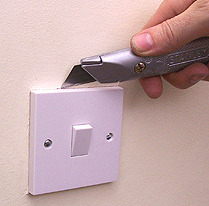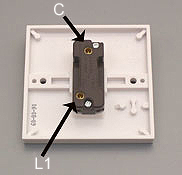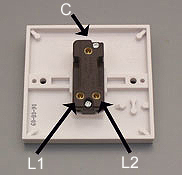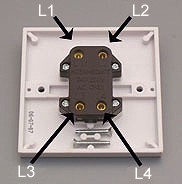 |
 |
Home
Tools
Drilling and Fixing
Putting Things Up
Repairs/Maintenance
Plumbing
Electrics
Woodwork
Decorating a Room
Tiling
Safety & Security
Saving Energy
House and Finance
Health&Safety
Disclaimer
Contact
Advertising
Useful Links
Site Map
| Replacing a light switch | |||||||||
| Replacing a light switch is fairly straightforward, but you need to take great care as you are dealing with electricity which can be dangerous. |  |
Recommended books |
|||||||
Make sure you turn the power off to the light switch at your consumer unit. |
|||||||||
Tip If it's an old switch that has been painted around many times over the years a good idea is to score round it with a sharp knife. This stops you pulling away the paint work on the walls. |
|||||||||
 |
|||||||||
Check that there is no live with your voltage checker, having previously checked that the voltage checker is actually working. |
|||||||||
You will see differing amounts or cable depending on what type of switch it is and how it has been wired. |
|||||||||
NB Metal switches must be earthed, and usually come supplied with an earth lead. This should be connected to the back box with the other earth cables that form part of the wiring. If you're replacing a plastic switch with a metal one and there is no earth to connect to call a qualified electrician. |
|||||||||
 |
|||||||||
| One way switch (UK light switch) A one way switch has a common (C) and Line out (L1) terminal. |
|||||||||
| Two way switch (UK light switch) A two way switch (for switching a light from two different locations like in a hallway) has a common (C) a L1 and an L2 terminal. L1 is off when L2 is on and vice versa depending on the switch position. You can use a two way switch for one way switching. Just ignore the L2 terminal. Some switches will actually come two way as standard for use as both. |
|||||||||
 |
|||||||||
An Intermediate switch(UK light switch) is used for switching a light from 3 or more locations in conjunction with two way switches. |
 |
||||||||
NB In light switches you are actually switching the live part of your circuit only so all of the cables(except the earths) even if they are different colours are actually part of the live not neutral. This may confuse you as the colours may be red and black for older cables or brown and blue if they are the newly introduced (post april 2006). This has been done for convenience when your wiring was done. If done properly the cables should have been clearly marked with colour coded sleeving as live. (red or brown) Any bare earth cables should have yellow and green earth sleeving. |
|||||||||